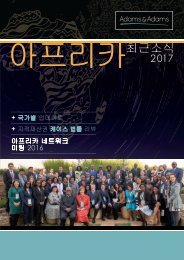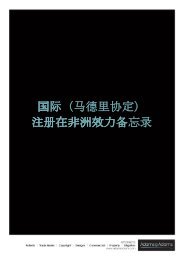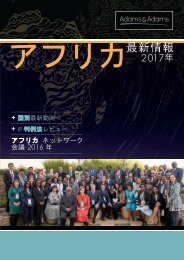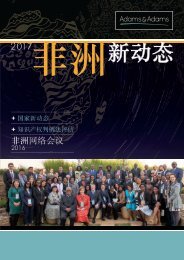Adams on Africa | Issue 2
Issue 2 of the Adams on Africa Newsletter by Adams & Adams Attorneys - with a focus on legislation, intellectual property, business and commercial news in Africa, especially in East Africa.
Issue 2 of the Adams on Africa Newsletter by Adams & Adams Attorneys - with a focus on legislation, intellectual property, business and commercial news in Africa, especially in East Africa.
You also want an ePaper? Increase the reach of your titles
YUMPU automatically turns print PDFs into web optimized ePapers that Google loves.
SOUTH AFRICA’S SUPREME COURT<br />
CLARIFIES SCOPE OF CPA’S PRODUCT<br />
LIABILITY PROVISIONS<br />
Danie Strachan looks at how a recent<br />
judgment provided clarity with regard to<br />
the principles of product liability in the<br />
c<strong>on</strong>text of the CPA.<br />
On occasi<strong>on</strong>, c<strong>on</strong>sumers might purchase goods<br />
that cause harm or injuries. Before South <strong>Africa</strong>’s<br />
C<strong>on</strong>sumer Protecti<strong>on</strong> Act (CPA) came into force, a<br />
c<strong>on</strong>sumer had to prove that the harm was caused by<br />
the negligence or intent of the supplier of the goods. However,<br />
the CPA changed this positi<strong>on</strong>.<br />
In terms of secti<strong>on</strong> 61, a goods supplier is liable for harm<br />
caused as a c<strong>on</strong>sequence of supplying unsafe goods, a product<br />
failure, defect or hazard in goods, or inadequate instructi<strong>on</strong>s<br />
or warnings, irrespective of whether the harm resulted from<br />
any negligence <strong>on</strong> the producer’s part or not. In essence, the<br />
c<strong>on</strong>sumer merely needs to prove that the goods caused harm<br />
and does not have to prove fault <strong>on</strong> the part of the supplier.<br />
In a recent case, a cyclist sued Eskom for severe electrical<br />
burns sustained after coming into c<strong>on</strong>tact with a low hanging<br />
power line while cycling. The cyclist’s claim was based <strong>on</strong> the<br />
strict liability placed <strong>on</strong> suppliers in terms of secti<strong>on</strong> 61 of the<br />
CPA. He alleged that the harm was caused due to the electricity<br />
supplied by Eskom and that Eskom was therefore liable. The<br />
Pretoria High Court held that Eskom was strictly liable in terms<br />
of secti<strong>on</strong> 61 of the CPA, stating that liability extended to “any<br />
natural pers<strong>on</strong>” who suffered harm caused by a supplier and<br />
not <strong>on</strong>ly a c<strong>on</strong>sumer within the c<strong>on</strong>text of the CPA.<br />
Eskom appealed against the High Court’s judgment. The<br />
Supreme Court of Appeal (SCA) examined the CPA as a whole<br />
and c<strong>on</strong>sidered the legislature’s intenti<strong>on</strong>. It decided that the<br />
plaintiff, as a cyclist, was not a c<strong>on</strong>sumer in relati<strong>on</strong> to Eskom<br />
because there was no c<strong>on</strong>sumer transacti<strong>on</strong> with Eskom, as<br />
a supplier of electricity, in the ordinary course of business.<br />
The plaintiff was also not the user of the electricity when the<br />
incident occurred. The SCA c<strong>on</strong>cluded that Eskom was not<br />
liable for the harm in terms of secti<strong>on</strong> 61 of the CPA and the<br />
appeal was therefore successful.<br />
This judgment provides clarity with regard to the principles<br />
of product liability in the c<strong>on</strong>text of the CPA. Suppliers can<br />
now be sure that the CPA’s provisi<strong>on</strong>s cannot be used to hold<br />
them liable for harm or damages that were caused outside the<br />
scope of a c<strong>on</strong>sumer transacti<strong>on</strong>. However, this does not mean<br />
that the supplier will escape resp<strong>on</strong>sibility. The supplier may<br />
still face liability under the comm<strong>on</strong> law, but the pers<strong>on</strong> who<br />
suffered harm would have to prove that the harm arose as a<br />
result of the supplier’s fault.<br />
For queries regarding the provisi<strong>on</strong>s and requirements<br />
of South <strong>Africa</strong>’s C<strong>on</strong>sumer Protecti<strong>on</strong> Act, c<strong>on</strong>tact the<br />
Commercial & Litigati<strong>on</strong> department at <str<strong>on</strong>g>Adams</str<strong>on</strong>g> & <str<strong>on</strong>g>Adams</str<strong>on</strong>g>.<br />
Gallo Images/Getty Images/Istockphoto/Alamy<br />
DEBUGGING MOBILE<br />
APP PATENT PROTECTION<br />
The commercial success of mobile applicati<strong>on</strong>s<br />
has resulted in an increasing interest in protecting<br />
associated intellectual property rights, such as<br />
patents, trade marks and copyright. Johnny<br />
Fiandeiro explains.<br />
A mobile app is a computer program designed to run <strong>on</strong> a<br />
mobile device, such as smartph<strong>on</strong>es and tablet computers,<br />
and comprises software <strong>on</strong> the mobile device that interacts<br />
with various servers.<br />
In general, an inventi<strong>on</strong> is patentable if it’s novel and<br />
inventive, but computer programs as such are generally not<br />
patentable. Mobile apps, however, and other computerimplemented<br />
inventi<strong>on</strong>s are typically protected by means<br />
of method claims in a patent specificati<strong>on</strong> – the method<br />
involving a series of steps, in respect of which a patentee<br />
claims exclusivity.<br />
To understand whether or not, and how, an app can be<br />
patented, it’s useful to determine whether the app addresses<br />
a problem in a unique way.<br />
In practice, however, it’s usually <strong>on</strong>ly the very specific features<br />
of an app that meet the relatively stringent criteria of novelty<br />
and inventiveness required for patentability.<br />
A comm<strong>on</strong> query, especially when c<strong>on</strong>sidering the speed<br />
at which mobile apps are launched and implemented, is<br />
whether it’s worth protecting a mobile app against replicati<strong>on</strong>.<br />
This is a valid query and c<strong>on</strong>cern and, in many respects, the<br />
patent system is not well-suited for protecting mobile apps<br />
because of related costs and time frames. Despite these<br />
factors, there are circumstances in which it makes very good<br />
sense to apply for patent protecti<strong>on</strong> for a mobile app (or at<br />
least for specific features of the app, as discussed above). In<br />
general, a patent is likely to provide the greatest commercial<br />
benefit where:<br />
• the expected lifespan of the technology is relatively l<strong>on</strong>g,<br />
typically at least three years;<br />
• the technology is of broad general interest, appeal or<br />
applicati<strong>on</strong>; and<br />
• there is scope for competitors to use the technology in their<br />
own apps, either to compete directly, or to develop new<br />
variati<strong>on</strong>s and applicati<strong>on</strong>s of their own.<br />
“<br />
As with all inventi<strong>on</strong>s, including<br />
mobile apps, the pros and c<strong>on</strong>s of<br />
obtaining patent protecti<strong>on</strong> as set<br />
out above need to be carefully<br />
c<strong>on</strong>sidered within the c<strong>on</strong>text of<br />
the commercial value (or potential<br />
commercial value) of the inventi<strong>on</strong>.<br />
WhatsApp is a good example of a start-up which put all<br />
its energy into developing its product and did not pursue<br />
patent protecti<strong>on</strong> (initially, at least). Facebook acquired<br />
no patents when it bought WhatsApp, although it currently<br />
has around six patent families. Arguably, patents would<br />
not have helped WhatsApp in any event because it<br />
created value through rapid growth of a low-cost service<br />
to c<strong>on</strong>nect users together. Even a competitor who tried<br />
to copy WhatsApp would have struggled to gain tracti<strong>on</strong><br />
am<strong>on</strong>g users.<br />
As with all inventi<strong>on</strong>s, including mobile apps, the pros and<br />
c<strong>on</strong>s of obtaining patent protecti<strong>on</strong> as set out above need to<br />
be carefully c<strong>on</strong>sidered within the c<strong>on</strong>text of the commercial<br />
value (or potential commercial value) of the inventi<strong>on</strong>.


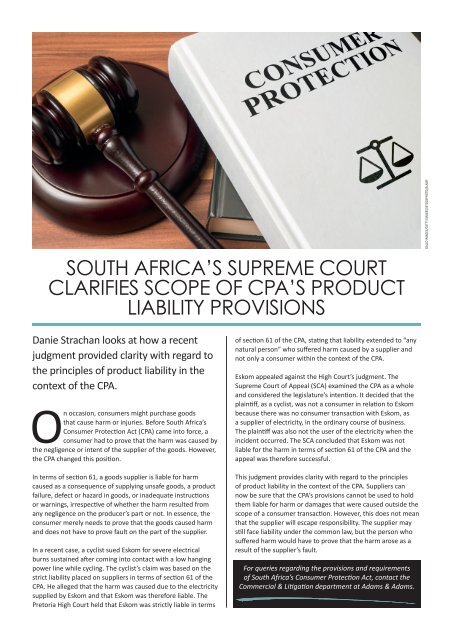




![Adams on Africa [Africa Update] Q3 2018](https://img.yumpu.com/61997083/1/184x260/adams-on-africa-africa-update-q3-2018.jpg?quality=85)

